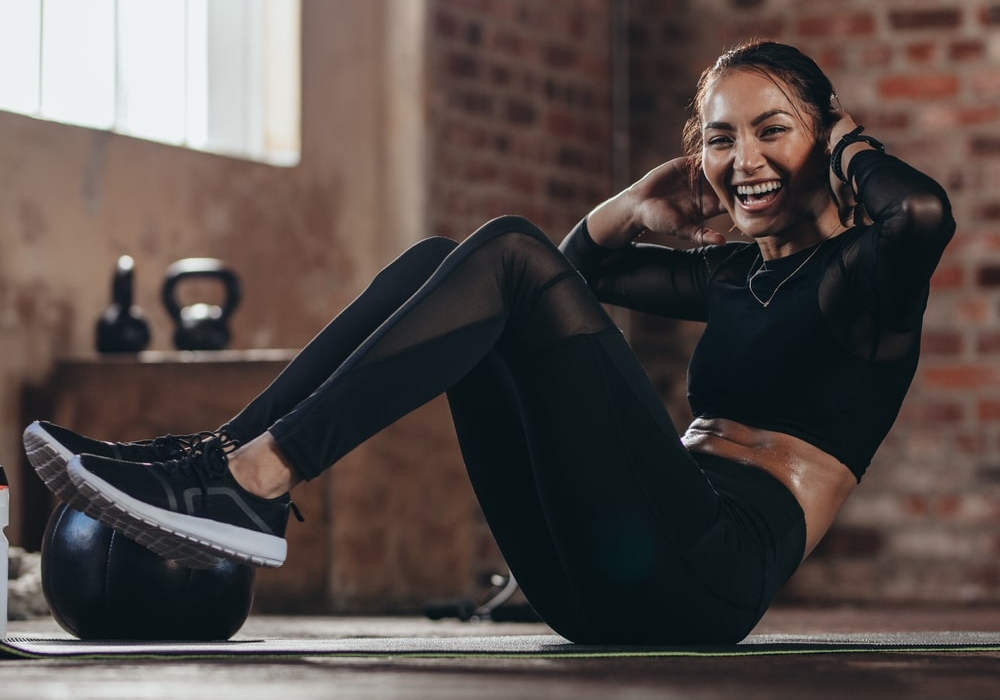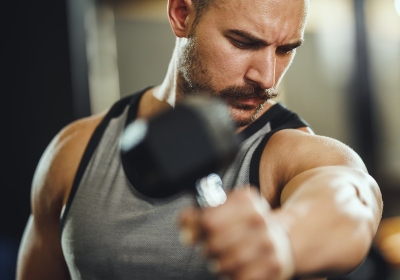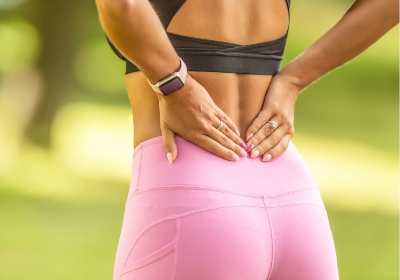VIDEO
Kettlebell Deadlift
- Core
- Biceps
- Lower Back
- Shoulders
- Gluteus
- Quads
- Thighs
Level:Intermediate
Trainer:Nick Taylor
Equipment:Kettlebell
Kettlebell Deadlift
- Core
- Biceps
- Lower Back
- Shoulders
- Gluteus
- Quads
- Thighs
Level:Intermediate
Trainer:Nick Taylor
Equipment:Kettlebell
Stand in a deadlift position and put a kettlebell in front of you. Keeping your back and knees as stright as possible, squat down grab a kettlebell with both hands and slowly explode up from this position. Repeat for the desired number of repetitions.
save to ...
RECOMMENDED FOR YOU
ARTICLES
The oblique abdominal muscles are several groups of abdominal muscles on the sides of the core. The external oblique muscle lies on top and the internal oblique muscle - below it. Functional exercises for training them are bending, turning to the sides, and other rotating movements.
However, in order to work your obliques properly, you must remember that most exercises for the oblique muscles involve the other abdominal muscles, the inner transverse muscles, in particular. That's why you need to be able to consciously engage certain areas of the abs during the workout.
The oblique muscles represent the lateral part of the abdominal area. They act as the main rotators of the body. They are represented by two separate muscles, depending on depth and layer:
The outer oblique abdominal muscle forms the superficial layer. It is usually the target of training. It anatomically begins from ribs 5-12.
The internal muscle originates from the lumbosacral fascia, iliac crest, and inguinal ligament. It is attached to the area of the white line, cartilages of ribs 9-12, and pubic crest.
The main task of the oblique abs is to rotate the torso. Although, in addition to the main one, the muscle performs a number of functions:
Tilting of the torso.
Flexion.
Lowering the ribs.
The tension of the anterior abdominal chest wall.
Bilateral contraction.
In general, in order to work your abs properly, it is necessary to follow simple recommendations:
Eat lightly 2-2.5 hours before the exercise. If you train with an empty stomach, you will not work out to your full potential, which means that the workout will be ineffective. An overfilled stomach can also leave negative consequences, such as nausea and severe dizziness.
Warm up your muscles by doing light exercises. Jump, run on the spot or on a machine, do simple tricks like turns, twists, and turns.
Do not overdo it! You don't need to exhaust yourself every day. Try 2-4 times a week - that will be enough for a nice and shapely belly.
Each exercise should stretch your muscles. You should feel how they are tensed. If this is not there, then you are doing something wrong.
Do not eat immediately after the workout. If you feel very hungry, snack on an apple or drink a glass of water. Do not eat after one hour at the earliest.
Read more
The shoulder muscles are divided into two groups. The anterior group consists of flexors: the coracohumeral, the brachialis, and the biceps brachii. The posterior group includes the extensors: the triceps brachii and ulnar.
The coracohumerals start from the coracoid process of the scapula fuses with the short head of the biceps brachii and pectoralis minor and attaches to the humerus at the level of the upper edge of the brachial.
The brachials start from the lower half of the anterior surface of the humerus and the intermuscular septa of the shoulder and attach to the tuberosity of the ulna and its coronal process.
The biceps brachii has two heads starting on the scapula from the supra-articular tubercle (long head) and the coracoid process (short head). It attaches to the forearm to the tuberosity of the radius and the fascia of the forearm. It belongs to the bicarticular part. Concerning the shoulder joint, the biceps of the shoulder is the flexor of the shoulder, and the elbow is the flexor and instep support of the forearm.
The triceps brachii is located on the back of the shoulder, has three heads, and is a bicarticular. It participates in the movements of both the shoulder and the forearm, causing extension and adduction in the shoulder joint and extension in the elbow.
The ulnar starts from the lateral epicondyle of the humerus and radial collateral ligament and the fascia; it is attached to the upper part of the posterior surface and partly to the olecranon of the ulna in its upper quarter. The function of this is to extend the forearm.
The bundles of the deltoid muscle perform different functions, so it will not work to load them all with one exercise: you will have to include at least three movements in the training. All exercises are divided into three parts: for pumping the front, middle and back beams. Pick exercises from our list below and add them to your workouts. The weight is necessary so that the last repetitions in the approach are given not easily, but without compromising the technique. You can train your shoulder straps both at home and in the gym. But it is necessary to have a bar and a gantry. Weight must be chosen in such a way that in every set it was possible to raise the average 8-10 times. This is how you can increase the volume and mass. If the same goal is set - to increase the strength, to train in the face of more severe conditions. In this case, the number of repeats will be 5-8. The number of reps is 4-5.
Barbell bench press. Take the shell on your chest, bring your elbows forward, tighten your abs, buttocks, legs. Squeeze the bar up, lower it back and repeat. When the bar passes your face, do not lift your chin, but squeeze it in yourself: this way the bar will go along the optimal trajectory. If the projectile remains in front of the body at the top point, and not above it, the load on the lower back increases. Therefore, try to take the barbell behind your head.
Standing dumbbell press. Raise your arms with the selected weight to shoulder level, turn your palms forward with your fingers. Squeeze the dumbbells up and take them slightly behind your head, and then lower them to the starting position and repeat. Do three to five approaches 10-12 times.
Seated Bent-Over Dumbbell Routing. Sit on a bench, tilt your body with a straight back, as far as flexibility allows, hold the dumbbells in your lowered hands. Without changing the position of the body, spread your arms with the taken weight on the sides to shoulder level. Slowly lower the dumbbells to the starting position and repeat.
Read more
Your lower back includes the 5 vertebral bones that are placed on top of each other with intervertebral discs. The bones are connected there using unique joints. The lumbar spine is matched with the thoracic region above and the thighs below.
Individual anatomical structures include :
Vertebrae. It protects important nerve tissues such as the spinal cord and cauda equina.
Disks. The discs usually provide cushioning and cushioning to protect the vertebrae during spinal movements.
Facet joints give a little stability and allow the spine to move in various directions. The facets of the upper lumbar vertebrae are almost the same as the facet joints of the chest and, as it was already written, the main aim is controlling the movement of the spine.
The facets of the lumbar are more flexible and facilitate side-to-side movement.
The large muscles and complex network of ligaments support serve to stabilize it and enhance your twisting and bending movements.
The lumbar supports most of the body. A lot of people feel this kind of pain at some point sometimes. Sedentary muscle atrophy is common, especially if you work in an office and lead a relatively sedentary lifestyle. If you want to make your lower back stronger, start with a regular training program that consists of strength training, stretching, and aerobics or cardiovascular exercise.
Training
Child's pose. Get on all fours and stretch your arms out in front of you. Gently lower your buttocks to your heels. Lower your head to the floor and push your palms forward until your arms are fully extended. Stay in this position for 30 seconds.
Lunges. Lunge with your right foot forward, rest on your hands. Please note that the right hand should be to the left of the leg. Step your right foot about the width of your right hand. Next, without moving your arms, swing your hips forward to stretch the front of the thighs, and hold in this position for 30 seconds. Do the same with the other leg.
Seated crunches. Sit with your legs straight, then bend your knees and bring your left leg over your right, placing it on the outside of your right thigh. Pull your right foot closer to your right buttock. Next, bend your right arm at the elbow and put it behind your left knee, as if keeping yourself twisted. Hold this position for 30 seconds. and repeat the same for the other leg.
Happy child. Lie on the floor, as you exhale, pull your knees to your stomach. As you inhale, grab the outer sides of your feet with your hands. Slightly spread the knees to the sides slightly wider than the body, pull the knees to the armpits. Make sure your shins are perpendicular to the floor. Hold this pose for 30 seconds.
Twisting. Lie on the floor and bend your knees, take your legs to the side, for example to the right. In this case, the left leg should lie on the floor, and the right ankle should be above the left knee. Place your hands next to your head, with your right knee strive downward (to the floor). Stay in this position for 30 seconds. alternately for each side.
Read more
One of the most important running muscles is the quadriceps - the large muscle at the front of the thigh. It has been scientifically proven that regular strength training improves workout performance and reduces the risk of injury, as well as strengthens your back, and leg muscles, making your running more productive.
The quads, also known as the quadriceps muscle, is a group of muscles located at the front of the leg above the knee. It is one of the largest and strongest muscles in your body that consists of four heads: fastus medialis (medial wide), vastus intermedius (intermediate wide), vastus lateralis (lateral), and rectus femoris (straight thigh muscle). Almost every action performed by the legs involves two or more heads of the quadriceps. The quadriceps muscle plays an important role at the beginning of the movement (quick start) and during ascent and descent in elevated positions - which is why you may experience painful sensations in this area of the leg after an intense uphill workout.
According to researchers at the University of Delaware, strong quadriceps act as cushioning and can protect the knees and the entire musculature of the hip from common running injuries. Often many runners are injured because they have weak and underdeveloped quadriceps, so it is especially important to strengthen them.
By training and strengthening the quads, you can get the following benefits when running:
Increased speed. Strong quadriceps help you tackle steep hills and climbs more easily and make pushing off the ground more powerful, resulting in increased speed.
Reduced injuries. According to research, poorly developed quadriceps are often associated with many running injuries. For example, a common injury such as the 'runner`s knee' results from weakness in these muscles, which are unable to stabilize the knee joint during the movement.
Increased endurance. Strengthening the quadriceps muscle will make your running more effortless and efficient, which contributes to increased running volume and endurance.
Training
The quadriceps occupy 70% of the muscle mass of the leg, so it is their development that is fundamental in leg training. The main exercise for developing the quadriceps is the squat. But, for beginners, at the first stages of training, it is better to start with leg curls sitting in an exercise machine, leg press, and hyperextensions to strengthen the lower back, to avoid injuries, in order to prepare the base for the heavy squats. It is a good idea to include squats in your training plan after about six months of training.
Read more
The hips are some of the strongest muscles in the human body. They keep the torso upright, control the hip and knee joints, and are engaged during various activities and even at rest. Their proper functioning is extremely important, and anyone should know how they function.
The muscles located on the hip are involved in both hip and knee movements, providing different positions of the hip in space depending on the proximal or distal support. Topographically, the hipі are divided into three groups. The anterior group includes the flexors: the quadriceps and the tailor muscle. The medial group consists of the hip drive muscles: the comb, the long, short, big adductor, and the thin muscle. The posterior group includes the hip extensors: biceps femoris, semitendinosus, and semi-perineal.
The lateral outer and inner thigh muscles are considered antagonistic pairs: while one group is working, the other group relaxes. The abductors, including the middle gluteal, small gluteal, thigh broad fascia tensor, pear, and tail muscles are responsible for your leg movements from the middle of your body.
Essentially, whenever you take a step to the side or turn your foot on the bed, you are activating the abductors. The inner thigh muscles, particularly the large adductor, small adductor, short adductor, and long adductor muscles perform the opposite task, working whenever you move your leg toward the center of your body.
Strong and injury-resistant athletes have well-trained hip muscles. This is very important when it comes to fast sports with a lot of lateral movements, such as tennis or basketball, but also when you want to work out without pain. If your goal is to strengthen your hip muscles, which is really important, but you don't have your favorite leg workout, we will share some great exercises with you.
Wide Squats. Every leg workout should include different variations of squats. This exercise targets the lower body, including the inner and outer thighs. But to really engage your thigh muscles, you should do deep squats with your legs turned outward.
Sumo Deadlift. The Sumo deadlift is based on a similar leg position as in the wide squat. However, it is the external rotation of the thigh muscles that results in increased involvement of the inner and outer thighs.
Side Leg Raises. A 2005 study published in the Journal of Orthopedic and Sports Physical Therapy found that side leg raises without weights are just as effective as other weighted exercises.
Side Leg Pull-Ups. The pull-up exercise can be done anywhere because you don't need anything but a comfortable mat. This is a great exercise that you can add to your daily home workout routine.
Read more
SAVE TO ...





